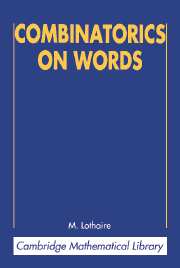Book contents
- Frontmatter
- Contents
- Foreword
- Preface
- Preface to this edition
- Chapter 1 Words
- Chapter 2 Square-Free Words and Idempotent Semigroups
- Chapter 3 Van der Waerden's Theorem
- Chapter 4 Repetitive Mappings and Morphisms
- Chapter 5 Factorizations of Free Monoids
- Chapter 6 Subwords
- Chapter 7 Unavoidable Regularities in Words and Algebras with Polynomial Identities
- Chapter 8 The Critical Factorization Theorem
- Chapter 9 Equations in Words
- Chapter 10 Rearrangements of Words
- Chapter 11 Words and Trees
- Bibliography
- Index
Chapter 3 - Van der Waerden's Theorem
Published online by Cambridge University Press: 04 November 2009
- Frontmatter
- Contents
- Foreword
- Preface
- Preface to this edition
- Chapter 1 Words
- Chapter 2 Square-Free Words and Idempotent Semigroups
- Chapter 3 Van der Waerden's Theorem
- Chapter 4 Repetitive Mappings and Morphisms
- Chapter 5 Factorizations of Free Monoids
- Chapter 6 Subwords
- Chapter 7 Unavoidable Regularities in Words and Algebras with Polynomial Identities
- Chapter 8 The Critical Factorization Theorem
- Chapter 9 Equations in Words
- Chapter 10 Rearrangements of Words
- Chapter 11 Words and Trees
- Bibliography
- Index
Summary
Introduction
This chapter is devoted to a study of van der Waerden's theorem, which is, according to Khinchin, one of the “pearls of number theory.” This theorem illustrates a principle of unavoidable regularity: It is impossible to produce long sequences of elements taken from a finite set that do not contain subsequences possessing some regularity, in this instance arithmetic progressions of identical elements.
During the last fifty years, van der Waerden's theorem has stimulated a good deal of research on various aspects of the result. Efforts have been made to simplify the proof while at the same time generalizing the theorem, as well as to determine certain numerical constants that occur in the statement of the theorem. This work is of an essentially combinatorial nature. More recently, results from ergodic theory have led to the discovery of new extensions of van der Waerden's theorem, and, as a result, to a topological proof.
The plan of the chapter illustrates this diversity of viewpoints. The first section, after a brief historical note, presents several different formulations of van der Waerden's theorem. The second section gives a combinatorial proof of an elegant generalization due to Grünwald. The third section, which concerns “cadences,” gives an interpretation of the theorem in terms of the free monoid. In the fourth section is presented a topological proof of van der Waerden's theorem, due to Fürstenberg and Weiss.
- Type
- Chapter
- Information
- Combinatorics on Words , pp. 39 - 54Publisher: Cambridge University PressPrint publication year: 1997



